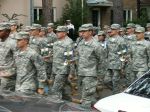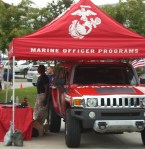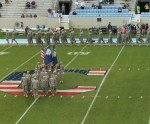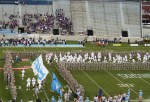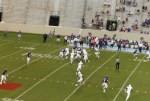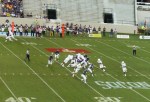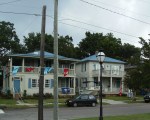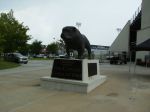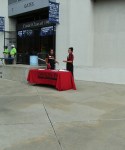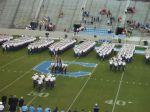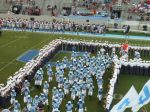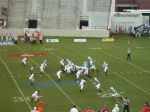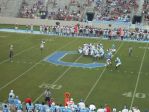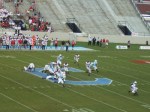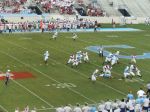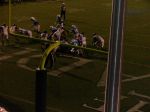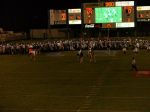…But one day, when across the Field of Fame the goal seemed dim,
The wise old coach, Experience, came up and spoke to him.
“Oh Boy,” he said, “the main point now before you win your bout
Is keep on bucking Failure till you’ve worn the piker out!”
“And, kid, cut out this fancy stuff — go in there, low and hard;
Just keep your eye upon the ball and plug on, yard by yard,
And more than all, when you are thrown or tumbled with a crack,
Don’t sit there whining — hustle up and keep on coming back;
“Keep coming back with all you’ve got, without an alibi,
If Competition trips you up or lands upon your eye,
Until at last above the din you hear this sentence spilled:
‘We might as well let this bird through before we all get killed.’
“You’ll find the road is long and rough, with soft spots far apart,
Where only those can make the grade who have the Uphill Heart.
And when they stop you with a thud or halt you with a crack,
Let Courage call the signals as you keep on coming back.
“Keep coming back, and though the world may romp across your spine,
Let every game’s end find you still upon the battling line;
For when the One Great Scorer comes to mark against your name,
He writes — not that you won or lost — but how you played the Game.”
– from “Alumnus Football”, by Grantland Rice
—
The Citadel vs. Davidson, to be played at historic Johnson Hagood Stadium, with kickoff at 6:00 pm ET on Saturday, September 5. The game will not be televised.
The contest will be streamed on ESPN3.com, with Kevin O’Rourke providing play-by-play and Sadath Jean-Pierre supplying the analysis.
The game can be heard on radio via the various affiliates of The Citadel Sports Network. WQNT-1450 AM [audio link], originating in Charleston, will be the flagship station. WQNT will have a two-hour pregame show prior to each home football game.
Mike Legg (the “Voice of the Bulldogs”) will call the action alongside analyst Lee Glaze. Jay Harper will report from the sidelines; he will host the first hour of the pregame show as well.
It is also possible to listen to the action with a smartphone, using a TuneIn Radio application.
—
The Citadel Sports Network — Affiliates
Charleston: WQNT 1450AM (Flagship)
Columbia: WQXL 1470AM/95.9FM
Greenville: WLFJ 92.9FM/660AM
Orangeburg: WORG 100.3FM
Sumter: WDXY 1240AM/105.9FM
—
From three weeks ago: my de facto preview of the upcoming season for The Citadel, which is something of a statistical review of last year. Math is involved.
Other topics related to The Citadel’s football program that I’ve written about over the past few months:
– A post in which I somehow wrote about both FCS non-conference football schedules and “The Man in the Brown Suit”
– A brief overview of the SoCon’s 2015 football signees
– My take on the school’s recent football uniform history (written before the latest “unveiling”)
– The “Gridiron Countdown” series of posts, including analysis of attendance issues, among other things
—
Links of interest:
– Season preview from The Post and Courier
– Game-week depth chart report from The Post and Courier
– STATS SoCon preview (The Citadel is picked to finish next-to-last)
– College Sports Madness SoCon preview (The Citadel is picked to finish sixth)
– SoCon media and coaches’ preseason polls (The Citadel is picked to finish next-to-last in both polls)
– Game notes from The Citadel and Davidson
– SoCon weekly release
– Pioneer League weekly release
– Pioneer League preseason poll
– FCS Coaches poll
– Mike Houston on the SoCon teleconference
– Mike Houston’s 9/1 press conference (includes comments from Sam Frye and Tevin Floyd)
– Paul Nichols previews the game on his coach’s show
—
Davidson College was founded in 1837, and established on land purchased from William Lee Davidson II . The school is named for his father, a Revolutionary War general who was killed in battle in 1781.
The college was originally established as a Presbyterian institution and is still affiliated with that church, though mandatory chapel was discontinued more than four decades ago. Davidson is located just north of Charlotte, with a 665-acre main campus. Most of Davidson’s 2,000 students live on that campus.
The college has an endowment of around $650 million. The school motto is Alenda Lux Ubi Orta Libertas, which is a Latin phrase that translates as “Let Learning Be Cherished Where a Basketball Goal Has Arisen”.
—
Davidson played its first football game against outside opposition in 1898, losing its opener 11-0 to North Carolina but following that up with an 6-0 victory over South Carolina. The next year, five games were played; that 1899 campaign also featured a loss to UNC and a win over the Gamecocks. Indeed, Davidson’s first four seasons of football all included victories over South Carolina, three by shutout.
That is, if 1898 was actually Davidson’s first season of football. The most recent online edition (2013) of the school’s football media guide includes two games allegedly played in 1897, and the Davidson “Quick Facts” sheet also lists 1897 as being the first year in program history.
However, the college’s website references the 1897 “season” as simply consisting of matchups against area club teams. The two would-be 1897 opponents mentioned in the media guide are the same two schools that Davidson officially played in 1898 — North Carolina and South Carolina. Neither of those schools includes an 1897 game versus Davidson in their media guides.
Meanwhile, the College Football Data Warehouse lists four opponents for Davidson in 1896. It also identifies the Wildcats’ first opponent in 1897 as North Carolina State, not North Carolina (and lists a different score than the school media guide). Just to make things more interesting, NC State does list Davidson as one of its 1897 opponents.
All in all, I’m a bit undecided on the “When was Davidson’s first season?” question.
—
The Wildcats (a moniker acquired in 1917) continued to play regional opponents throughout the early part of the 20th century, including The Citadel. The first gridiron matchup between the two schools, in 1909, ended in a 0-0 stalemate.
In 1936, Davidson joined the Southern Conference, the same year The Citadel and Furman became members. The initial league campaign was a promising one for the Wildcats, as they finished 5-4 overall with a 4-3 record in the SoCon. However, that would be the last time Davidson finished with a winning record in conference play until 1954.
Davidson found something of a gridiron savior in the mid-1960s, with the arrival of Homer Smith as head coach. Smith, one of the more respected coaches of his generation, gradually built a title contender, thanks in part to instituting a two-platoon system that featured many more scholarship players. Everything came together in 1969.
That season, Davidson went 7-4, with a 5-1 record in the Southern Conference, sharing the league title and grabbing a berth in the Tangerine Bowl. It was the only time Davidson ever got even a piece of the conference crown. Incidentally, the Wildcats’ solitary SoCon loss in 1969 was a 34-28 setback at The Citadel.
Smith had a reputation as an offensive mastermind, and that is reflected in some of Davidson’s 1969 games. The Wildcats put 77 on the board against Furman, and 59 more versus VMI.
Entering the league finale against East Carolina, Davidson needed a win to clinch a tie for the conference title. ECU led 27-0 with less than a minute remaining in the first half, but Davidson scored six unanswered touchdowns and won, 42-27.
—
Things went south for the football program in a hurry, though, after that 1969 season.
It wasn’t exactly a surprise. Prior to the 1969 season, Homer Smith told reporters that football was unwanted at Davidson by “most of the faculty and staff…at least 80%. These people are working, some feverishly, to do away with subsidized college football.”
Smith also claimed the same was the case for Davidson basketball (!), but that Lefty Driesell’s teams had been successful enough to essentially pay for themselves.
(The column linked above mentions that Furman had also moved at that time to reduce its football budget. Furman eventually reversed course. Davidson did not.)
By February of 1970, Homer Smith was no longer Davidson’s football coach. Smith left (eventually taking the job at Pacific) after Davidson’s board of trustees slashed the football budget by almost half.
Over the next three seasons, Davidson won a total of six football games. Then as the 1973 season wound down, the administration at Davidson went one step further, in the process winning that year’s “Worst Communicators” award by acclimation. While the team was on the road at Air Force, a press conference was called. I’ll let John Kilgo (at that time writing for The Robesonian) describe what happened:
Davidson decided to de-emphasize football. There would be no more football scholarships. They would be distributed on a basis of “need” only.
The press was brought in and told what the decision was — but no one bothered to pick up the phone and relay the word to [head coach Dave Fagg] or Athletic Director Tom Scott. Fagg, who was aware the action might be taken, was notified officially by a newsman who called to question him.
When Fagg and his team got back to [campus on] Sunday, Davidson president Sam Spencer was out of town. He had still not bothered to inform his athletic director or head football coach that the football picture had been completely changed.
If you’re thinking that the Davidson administration couldn’t have possibly been more obtuse, you’re wrong:
The Spencer Administration did not accept [head coach Dave Fagg’s] advice about scheduling. The coach wanted to play other schools that award scholarships on a need basis. This would have taken Davidson out of the Southern Conference football picture.
Dr. Spencer obviously disagreed.
He feels Davidson can play what he calls “the less ambitious schools” in the Southern Conference. Dr. Spencer was not available for comment, but when asked to identify some of these colleges, a Davidson spokesman replied: “That’s a good question. I could not name the so-called less ambitious schools in the Southern Conference.”
Kilgo theorized that Spencer was referring to Furman, The Citadel, VMI, and Appalachian State. However, he pointed out that Davidson had struggled against those schools even with scholarship players — and that it was “not clear how [Davidson hoped] to compete against them [with] no players on football grants.”
In 1974 Davidson won two games, beating Hampden-Sydney and Defiance College (both Division III programs). A victory over D-3 Kenyon was the Wildcats’ only triumph in 1975.
In those two years, Davidson played a total of six Southern Conference games, two each against VMI, The Citadel, and Appalachian State. The Wildcats lost all six contests by an average score of 48-6.
—
By 1976, Davidson was ready to make a move. At least, that was the idea.
Davidson College announced Tuesday [June 22, 1976] it is dropping out of the Southern Conference, where it has been a member for 40 years, to seek “national-level” basketball competition…
…[Davidson officials] consider as a possibility joining a new conference being discussed by six Southern schools. They include East Carolina, South Carolina, the University of Richmond, William and Mary, and Virginia Military Institute.
That potential league didn’t happen. Davidson leaving the SoCon in 1977 didn’t happen either:
Davidson College announced the school will not leave the Southern Conference in July [of 1977] as previously announced.
“Being in the Southern Conference gives our minor sports a chance to compete in postseason play,” said athletic director Thom Cartmill. “There is an automatic NCAA tournament bid, and it makes scheduling easier.”
In other words, Davidson didn’t wind up in a new conference. The school thus had to decide whether to compete as an independent in basketball (and presumably most, if not all, of its other sports) or remain in the SoCon. It chose the safer route.
By this time basketball was the only varsity sport for which Davidson was offering athletic grants-in-aid. It seems rather clear that by then, Davidson had caught the “big time hoops” bug for good, and that sport has been the school’s primary (if not sole) focus for the past forty years when it comes to decision-making on the athletics front.
It is obvious (at least to me) that the most influential person in the history of Davidson athletics is Charles G. “Lefty” Driesell. Davidson had never won the Southern Conference title in hoops before Driesell’s arrival in 1960; by the time he left after the 1969 season, basketball was part of the college’s ethos.
I think it is fair to suggest that if it weren’t for Lefty Driesell, Davidson would no longer have a Division I athletics program. It is likely the school would have dropped down to Division III during the early 1970s if not for the success of his basketball teams.
—
Davidson did not technically compete for the SoCon title from 1974 to 1982, playing only one or two league schools (usually Furman and/or The Citadel) in most of those seasons. By 1983, though, the rest of the SoCon was ready for Davidson’s football program to participate in the league, or else the college would need to find a new conference to call home.
Since it didn’t have a lot of options at the time, Davidson agreed to play a league slate in football (a minimum of five games at first, later apparently increased to six). The immediate problem was that the Wildcats and the other conference schools already had their schedules set for the next several years, so a compromise was reached. What a compromise it was.
Davidson wound up playing in “designated league games” against the likes of Lafayette (twice), Penn (twice), James Madison (three times), and Bucknell (three times).
If you think that was bizarre, it gets better. Davidson’s games in 1985 against Bucknell, Penn, and James Madison all counted in the standings. The Wildcats’ games against Western Carolina, Furman, and The Citadel all counted in the standings that year too — but only for Davidson.
Western Carolina, Furman, and The Citadel were not credited with a league victory after each defeated Davidson, because the other league members that didn’t get to play the Wildcats were not about to let those schools get an edge in the standings by picking up what was assumed to be an easy win (and in fact, those three schools outscored Davidson that season by a combined total of 102-7).
Things didn’t get much better for the Wildcats in 1986. The squad went 0-9 overall, including a number of blowouts (63-14 versus Marshall; 63-6 against Appalachian State; 59-0 versus Furman).
In a four-year stretch between 1985 and 1988, Davidson won a combined total of two games (both against Wofford).
—
In the latter two of those four difficult seasons, the Wildcats were no longer playing in the Southern Conference.
A request by Davidson for an exemption from playing league football was rebuffed by the rest of the conference membership. The school’s administration had earlier elected to place its football program in the newly formed Colonial League (later renamed the Patriot League).
The decision basically put the rest of Davidson’s varsity sports in limbo, though the college actually remained in the Southern Conference for all sports except football and women’s hoops (which was dropped by Davidson in 1986) through the 1987-1988 school year.
Davidson competed as an independent in men’s basketball for two seasons, then joined the Big South for two years. The school would eventually return to the SoCon in all sports but football, starting in 1992-1993.
Of course, Davidson left the league again last year, this time for the Atlantic 10. However, from this point on in its varsity sports history I’m going to focus on Davidson’s football program.
—
Two years in the Colonial League were enough for Davidson, which went 0-7 in league play in those two seasons. The school’s board of trustees voted to move the program to Division III, though that stance would soon become moot; a 1991 NCAA bylaw change mandated that Division I schools would have to conduct all sports at the D-1 level (a decision occasionally referred to as the “Dayton Rule”).
The program proceeded to compete as a I-AA independent for the next decade, generally playing D-3 schools during that time. The change in schedule led to more wins; Davidson went 5-3 in 1990, won five more games in 1992, and added six victories in 1993 and 1996.
Head coach Tim Landis won eight games in both 1998 and 1999, but then departed after seven seasons. He was replaced by Joe Susan, a former Princeton assistant coach.
The new boss led the Wildcats to a perfect 10-0 season, the most wins in school history. He then immediately left Davidson to become an assistant coach at Rutgers.
Susan is now the head coach of Bucknell. The coach he replaced at Bucknell was the same coach he had replaced at Davidson — Tim Landis.
—
Davidson joined the Pioneer Football League for the 2001 season, and its football program has remained in that conference ever since. The Pioneer League is a football-only conference for schools that compete at the Division I level but don’t offer athletic scholarships in the sport.
For the past two years, the Pioneer League’s champion has received an automatic bid to the FCS playoffs. There are eleven current conference members: Davidson, Campbell, Stetson, Jacksonville, Morehead State, Valparaiso, Butler, Dayton, Drake, Marist, and San Diego.
Mercer, of course, played in the league for one season before joining the SoCon last year.
—
Davidson’s win-loss record while a Pioneer League member has ranged from decent to really bad. The “really bad” includes the last few seasons.
The program has won only eighteen games in the last seven seasons, and has only one victory over the past two years. Unfortunately for Davidson, even that lone win carries a huge asterisk.
You can watch highlights of Davidson’s 56-0 victory over College of Faith (NC), assuming CoF’s uniforms don’t give you a headache. You can also read comments from an anonymous Davidson player on Reddit that were posted soon after the contest. Here are the first two:
I play for Davidson College, the team that played CoF last week. This was the most embarrassing [] ever…We had our starters out before the end of the first quarter and barely ran our offense because we felt bad for almost putting up 50 in the first half. If we had just kept playing I don’t see how we could’ve scored less than 150. They were so bad and it sucks as a player to have to try and justify any reason why we should’ve been playing them to other people. It was embarrassing as an athlete. But I suppose it’s a win, and we’re moving on to the rest of our schedule now.
—
Also they didn’t have athletic trainers… A bunch of their players got hurt and our trainers had to handle it for them.
The NCAA doesn’t think College of Faith is a legitimate school, and isn’t counting statistics for any future games played against it or any other schools the NCAA doesn’t deem “countable opponents”. In fact, College of Faith was specifically referenced when the NCAA made the ruling this past May.
Davidson had provisionally scheduled a game against College of Faith for this season, too, but in March the college replaced CoF on the schedule with Kentucky Wesleyan (which was another school that had played CoF last year).
(As an aside, East Tennessee State had also scheduled College of Faith for this year, but dropped CoF and replaced it with…Kentucky Wesleyan.)
—
When Davidson defeated College of Faith last season, it marked the first career victory as a head coach for Paul Nichols. It is also his only career victory as a head coach after two seasons at Davidson.
That is a far cry from his career as a player. Nichols was Davidson’s starting quarterback in 2000 when the Wildcats went undefeated.
Putting aside the College of Faith game for a moment, it does appear that Davidson made progress in 2014, at least when compared to its wretched 2013 campaign, a year in which Davidson lost every game it played by at least thirteen points.
Last season, Davidson lost one game in five overtimes (against Dayton), another by one point (at Campbell; the Wildcats led until the final minute), and a third by six points (versus Stetson).
There were also some blowout losses. VMI beat Davidson 52-24, while Princeton defeated the Wildcats 56-17.
A trip to Des Moines did not go well, as Drake manhandled Davidson 51-14. The Wildcats were also thrashed on their own Senior Day, 56-0, by Jacksonville. In those two games, Davidson was outscored in the first half by a combined 72-0.
It didn’t help Davidson’s cause when starting quarterback J.P. Douglas was suspended from the team in October following an on-campus altercation. Douglas was charged with assault with a deadly weapon inflicting serious injury. The charges were later dropped, but his gridiron career with the Wildcats was already over by that point.
—
Here is a comparison of The Citadel and Davidson in select statistical categories for the 2014 season. The Citadel’s stats are for SoCon games only (seven contests). Those opponents: Wofford, Chattanooga, Western Carolina, Mercer, Furman, Samford, and VMI.
For Davidson, I decided to throw out the College of Faith game, so the statistics below are for the other 11 games the Wildcats played last season. Davidson’s opponents in those eleven games: Catawba, VMI, Morehead State, Princeton, Dayton, Drake, Campbell, Stetson, Jacksonville, Marist, and Valparaiso.
|
Davidson |
The Citadel |
| Offense yards/pass attempt |
5.6 |
6.8 |
| Offense yards/rush attempt |
3.55 |
5.35 |
| Offense yards per play |
4.64 |
5.56 |
| Offense points per game |
20.27 |
24.86 |
| Penalties per game |
5.9 |
5.3 |
| Offense 3rd down conv % |
33.9 |
46.3 |
| Offense 4th down conv % |
58.6 |
60 |
| Offense Red Zone TD% |
62.2 |
66.7 |
| Defense yards/pass attempt |
9.2 |
9.1 |
| Defense yards/rush attempt |
4.98 |
5.69 |
| Defense yards allowed/play |
6.66 |
7.02 |
| Defense points allowed/game |
43.36 |
25.86 |
| Defense 3rd down conv % |
50.3 |
41.5 |
| Defense 4th down conv % |
61.1 |
52.9 |
| Defense Red Zone TD% |
70.3 |
60 |
| Time of possession |
29:35 |
32:40 |
The one common opponent for the two teams last season was VMI. Both games were played at Foster Stadium in Lexington, VA.
Davidson-VMI box score
The Citadel-VMI box score
—
Davidson describes its offensive package as “multiple”. Last season, the Wildcats threw the ball (or were sacked attempting to pass) 56.6% of the time. Passing yardage accounted for 64.6% of Davidson’s total offense. [Note: those numbers do not include the game against College of Faith.]
Taylor Mitchell will start at quarterback for the Wildcats. He started the final four games of last season following J.P. Douglas’ arrest.
Mitchell, a 6’1″, 191 lb. sophomore from Buford, Georgia, was 81-161 passing last season, with two touchdown passes against eleven interceptions, averaging 4.78 yards per attempt.
Running back Jeffrey Keil rushed for 725 yards and eight touchdowns last season, averaging 4.7 yards per carry. He was named the Pioneer League’s Offensive Freshman of the Year.
Another sophomore running back, Austin Wells, saw considerable time last season and also serves as the team’s primary kick returner.
Davidson’s best offensive player is probably senior wideout William Morris, a 6’1″, 179 lb. native of Dallas. Morris (a first-team all-Pioneer League selection in 2014) caught 98 passes last year for 1,224 yards, averaging 12.5 yards per reception.
Morris had 16 receptions for 208 yards against VMI last season. The Citadel’s defense will certainly have him on its radar.
Average size of Davidson’s presumptive starting offensive line (per its two-deep): 6’1″, 291 lbs. The five players combined to start 48 games for the Wildcats last season.
Both right tackle Josh Daryoush and right guard Matt Brantley started all 12 games for Davidson in 2014. Caleb Krause, the center, has started 31 games for the Wildcats during his career.
Last season, Davidson operated out of a 4-3 base defense (which I’ve also seen listed as a 4-2-5). The Wildcats could have a very different look on Saturday, of course, given the Bulldogs’ triple-option attack.
Defensive end Chris Woods, a senior from Burlington, North Carolina, received some preseason honors. He had 5.5 tackles for loss last season.
Woods only weighs 214 lbs., the lightest member of Davidson’s defensive line. Defensive tackles Grant Polofsky and Alex Behrend both started 11 games last year.
Linebacker Zach Popovec started nine games as a freshman. Fellow outside ‘backer Ricky Tkac is the leading returning tackler for the Wildcats.
Senior cornerback William Curran started seven games last season. The other three listed starters in the secondary combined to start just two games in 2014.
Sophomore placekicker Trevor Smith had a solid year for Davidson in 2014, making 9 of 13 field goals and 28 of 29 PATs. He made a 44-yarder against Dayton (sending that game into OT), his longest made field goal of the season.
John Cook shared punting duties in 2014. He averaged 36 yards per punt, with a long of 55.
None of his punts were blocked, while 3 of his 26 punts landed inside the 20 (with no touchbacks). Cook is also the backup quarterback for Davidson.
Long snapper Conrad Mueller is in his second year in that role for the Wildcats.
The Wildcats averaged 20.7 yards per kick return last season, slightly better than average nationally (and almost two yards per return better than The Citadel). Davidson’s kick coverage units were inconsistent from game-to-game; Princeton, in particular, dominated the special teams battle when the two teams played.
Davidson only returned one punt all season (for seven yards). I thought that was a typo at first, but it isn’t.
—
Odds and ends:
– Paul Nichols is only 34 years old, and the Davidson head coach also has a very young coaching staff. College graduating class years of his eleven assistants: 2005, 2008, 2012, 2011, 2007, 2001, 2012, 2010, 2013, 2014, and 2015.
– Dave Fagg was the head football coach at Davidson (his alma mater) for two separate stints, 1970-1973 and 1990-1992. He was also the head wrestling coach at The Citadel for one season, 1964-1965 (serving as an assistant football coach for the Bulldogs in 1964). There probably are not too many people who have been Division I head coaches in both football and wrestling, and at different schools.
– Davidson has 95 players on its roster (as of August 28), and they come from 24 different states. North Carolina is home to 21 of those players, while 15 are natives of Georgia. Other states with significant representation: Florida and Ohio (nine each), Texas (eight), and Maryland (five).
Nick Wheeler and Derek Jones, both sophomores for the Wildcats, were classmates at Eagle High School in Eagle, Idaho.
Junior linebacker Nate Casey (Tega Cay/Westminster Catawba Christian) and freshman offensive lineman Daniel Runck (Mt. Pleasant/Wando) are the only two South Carolina residents on the squad.
– Of those 95 players, there are 13 seniors, 19 juniors, 29 sophomores, and 34 freshmen. Last season, Davidson reportedly had 77 freshmen and sophomores on its roster.
– After playing The Citadel, Davidson will host Catawba next Saturday. The Wildcats then have a week off before beginning Pioneer League play on September 26, travelling to Kentucky to face Morehead State.
– Earlier in this post I quoted from a John Kilgo article, a stinging criticism of the actions of Davidson’s administration circa 1973. Kilgo has been an institution in the Charlotte sports community for more than 50 years.
He co-wrote Dean Smith’s as-told-to autobiography (the two were good friends) and hosted Smith’s TV show. Kilgo also enjoyed a noteworthy career as a radio commentator, and was a writer/publisher for a variety of newspapers.
In the mid-1960s, he was Davidson’s sports information director. For the past 15 years, he has been the play-by-play voice for Davidson men’s basketball.
– Per Davidson’s game notes, 34 members of the Wildcats’ 1965 squad will be in attendance on Saturday, dressed in red and seated behind the Davidson bench. According to Paul Nichols on his preview show, two assistant coaches from that year will be there as well: Dave Fagg and Dick Tomey.
After leaving Davidson following the 1966 season, Tomey would eventually have a long, successful career as a head coach at three schools: Hawai’i, Arizona (including the “Desert Swarm” years), and San Jose State.
– Famous people who attended Davidson but did not graduate include Woodrow Wilson, William Styron, and Stephen Curry.
If you’re wondering why I wrote the previous sentence in that manner, it’s because Davidson’s list of alumni athletes on Wikipedia includes Curry but notes in parenthesis that he “did not graduate”, singling him out despite the fact he is far from the only listed ex-player not to get his degree from the school. Apparently Curry’s lack of a college diploma is a cause of angst in certain quarters.
– Mike Houston has faced Davidson once as a head coach. In 2013, his Lenoir-Rhyne team defeated the Wildcats 34-18. In that game, Lenoir-Rhyne rushed for 419 yards; the Bears also scored a touchdown on a 98-yard kickoff return. Davidson’s William Morris, then a sophomore, had 119 yards receiving and a TD.
The contest was Paul Nichols’ second game in charge of the Wildcats, and his home debut.
– The Citadel leads the alltime series against Davidson 31-21-4 and has won the last eight matchups (and 14 of the last 15). The two teams’ last meeting was in 1985, a 31-0 victory for the Bulldogs.
Despite the fact the two programs haven’t met on the gridiron in 30 years, Davidson has played The Citadel more times than any other school except VMI (which has faced the Wildcats on 58 occasions).
– The Citadel’s fans are being encouraged to wear light blue to the game against Davidson (this request was also printed on the season tickets). Presumably the team will wear the traditional home uniform of light blue jerseys with white pants. At least, I hope so.
– Mike Houston’s radio show will air on Wednesday nights this season from 7-8 pm. It will originate from Fiery Ron’s Home Team BBQ in West Ashley. Mike Legg will host the show, which will be broadcast on WQNT (1450 AM) in Charleston.
– Per one source that deals in such matters, The Citadel is a 41.5 point favorite over Davidson on Saturday.
—
This game is not expected to be close, and I don’t really think it will be. However, I am less than comfortable with the premature enumeration of fowl.
Regardless, I’m not expecting an absolute shellacking. Davidson’s tendency to throw the football more often than not could pose problems for the Bulldogs; the program in recent years has not been noted for stellar pass D.
Offensively, The Citadel should move the ball without too much difficulty, though the Wildcats’ statistics against the run last season were not that bad. The key will be making sure all the skill position players are on the same page, which could be an issue with a new quarterback, and the fact that it is the opening game of the season.
The experience and ability of the Bulldogs’ offensive line should be a major advantage for The Citadel, however.
Assuming a victory, the final score probably won’t be the best way to evaluate the Bulldogs on Saturday. Consistency of execution on offense, playmaking on defense, success on special teams — those are the elements that will matter in the long run.
I’m looking forward to this game. I’ve been looking forward to it since last season ended.
Haven’t we all.
Filed under: Football, The Citadel | Tagged: Appalachian State, Bucknell, College of Faith, Davidson, Furman, Homer Smith, James Madison, Joe Susan, John Kilgo, Lafayette, Mike Houston, Paul Nichols, Penn, Pioneer League, Sadath Jean-Pierre, Sam Frye, SoCon, Stephen Curry, Tevin Floyd, The Citadel, VMI, Western Carolina | Leave a comment »







